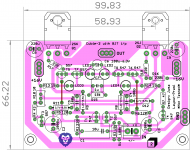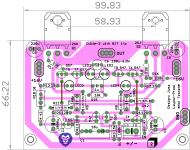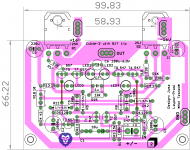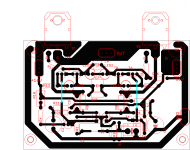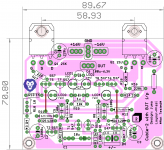Yassou, my Greek friend!.
is this what you are looking for?
regards
Prasi
here is eliminating 3rd jumper and possibility to couple T 1/ T2.
Also gnd lift res, if required can be put.
reg
Prasi
Attachments
some what more optimized, if I may...
like thimious said thro PM, very interesting amp (to lay it out, for me!).
Now I think its optimized, but will still keep on working on it, it my habit!
like thimious said thro PM, very interesting amp (to lay it out, for me!).
Now I think its optimized, but will still keep on working on it, it my habit!
Attachments
Last edited:
Prasi!Yassou, my Greek friend!.
is this what you are looking for?
regards
Prasi
Yassou Prasi!Really fast!!!!🙂
Thanks my friend😎
Just an option....moving the +/- power terminals close together with the GND terminal if possible.
Attachments
Last edited:
Prasi!
Yassou Prasi!Really fast!!!!🙂
Thanks my friend😎
Just an option....moving the +/- power terminals close together with the GND terminal if possible.
I can do it, but would you mind it if the o/p devices are some what submerged under the pcb? like the 'quasi complementary amp by AKSA/Ranchu32?
that would call for separate ground connection for i/p section like the Cubie-3? would you be comfortable with that?
reg
Prasi
Last edited:
Let's wait Juma's opinion,guides.
ok,
Hi Juma,
here is high contrast image as you prefer it. schematic with component names in post #160. PCB image as viewed from component side.
reg
Prasi
Attachments
Last edited:
Looks all right - watch the details: R16 in layout (R20 in sch., post #145) goes to signal GND not to power GND...
Last edited:
Looks all right - watch the details: R16 in layout (R20 in sch., post #145) goes to signal GND not to power GND...
Thank you Juma, corrected in attached layout🙂.
To thimios,
are you suggesting something like the attached?😀
reg
Prasi
Attachments
Last edited:
Yes,but now C2,C3 attached at the signal gnd. Schematic say POWER GND😕Thank you Juma, corrected in attached layout🙂.
To thimios,
are you suggesting something like the attached?😀
reg
Prasi
Yes,but now C2,C3 attached at the signal gnd. Schematic say POWER GND😕
No, C2/C3 (C4/C5 in Juma sch) are indeed attached to signal ground. Juma's sch shows only the signal ground.
Ok got it😉No, C2/C3 (C4/C5 in Juma sch) are indeed attached to signal ground. Juma's sch shows only the signal ground.
OK, it will work, it's just that I usually try to concentrate sensitive GND points to a small area (see post #1). You got a lot of copper and long lines in signal GND (post #168).
post168.
You now have the V+, V- and PG all grouped together to minimise EMI from the power lines. This is much better for reducing interference effects.
Add in HF supply rail decoupling where the PG is next to V+ and V-.
What are C2 and C3 doing? They appear to be connected to the Signal Return.
The unlabelled resistor between PG and Signal Return (-IN) allows a reference voltage between zero volts and input.
This resistor may have to pass Fault Current if the Source equipment becomes faulty and has no route (classII) to blow the mains fuse.
This resistor needs to be protected from failing until that remotely located mains fuse blows. Add in a pair of inverse parallel diodes across the resistor.
You now have the V+, V- and PG all grouped together to minimise EMI from the power lines. This is much better for reducing interference effects.
Add in HF supply rail decoupling where the PG is next to V+ and V-.
What are C2 and C3 doing? They appear to be connected to the Signal Return.
The unlabelled resistor between PG and Signal Return (-IN) allows a reference voltage between zero volts and input.
This resistor may have to pass Fault Current if the Source equipment becomes faulty and has no route (classII) to blow the mains fuse.
This resistor needs to be protected from failing until that remotely located mains fuse blows. Add in a pair of inverse parallel diodes across the resistor.
Last edited:
post168.
You now have the V+, V- and PG all grouped together to minimise EMI from the power lines. This is much better for reducing interference effects.
Add in HF supply rail decoupling where the PG is next to V+ and V-.
What are C2 and C3 doing? They appear to be connected to the Signal Return.
The unlabelled resistor between PG and Signal Return (-IN) allows a reference voltage between zero volts and input.
This resistor may have to pass Fault Current if the Source equipment becomes faulty and has no route (classII) to blow the mains fuse.
This resistor needs to be protected from failing until that remotely located mains fuse blows. Add in a pair of inverse parallel diodes across the resistor.
C2 C3 part of feedback network?
post1 schematic does not show C2 & C3 connected to the Signal Return.
They are connected to different points inside the circuit.
Your C2 & C3 must be in a different schematic. Which?
They are connected to different points inside the circuit.
Your C2 & C3 must be in a different schematic. Which?
post # 1 is original JFET version of Cubie 2 amp.
Someone requested BJT i/p of Cubie-2 and Juma posted here..post #145.
http://www.diyaudio.com/forums/pass-labs/271543-cubie2-15.html#post4537151
I did my layout of the same and my sch (which is same as Juma BJT but different part numbers) is posted here. post no. 160
http://www.diyaudio.com/forums/pass-labs/271543-cubie2-16.html#post5116401
Someone requested BJT i/p of Cubie-2 and Juma posted here..post #145.
http://www.diyaudio.com/forums/pass-labs/271543-cubie2-15.html#post4537151
I did my layout of the same and my sch (which is same as Juma BJT but different part numbers) is posted here. post no. 160
http://www.diyaudio.com/forums/pass-labs/271543-cubie2-16.html#post5116401
Ah, the DC block in the NFB route.
Yes, these go to the Signal Return. That's where the amplifier measures the input signal.
and yes you have located the unlabelled resistor in the correct location to allow the output to reference the same voltage as the input.
Yes, these go to the Signal Return. That's where the amplifier measures the input signal.
and yes you have located the unlabelled resistor in the correct location to allow the output to reference the same voltage as the input.
thanks everyone for your suggestions , have most of them incorporated.
To, thimios , are you ready for experimentation?
To, thimios , are you ready for experimentation?
Attachments
- Home
- Amplifiers
- Pass Labs
- Cubie2
